SEO
SaaS Homepage SEO: Keywords, Linking & More

Start-up SaaS websites typically consist of the home page and maybe a handful of supporting pages – neither of which offer any SEO value.
A good SaaS homepage will drive conversions and improve your business on the whole. But how do you optimize yours?
In this article, you will learn about SaaS homepage SEO challenges, the role your homepage plays in SEO, and different keywords to consider when optimizing a SaaS homepage.
Why Is Homepage SEO So Challenging For SaaS Brands, Specifically?
Let’s face it, homepage SEO is confusing for almost everyone.
Whether it is a SaaS company, a local company, or another business type, you’ll find many in each vertical who struggle to make good use of this real estate from an SEO perspective.
At the same time, the homepage is also the one asset almost every business cares about the most.
It’s often the primary landing page, regardless of the traffic source. Because of that, it’s also that one asset that most often:
- Welcomes visitors.
- Makes a first impression about the brand.
- Describes what the company does (or at least hint at it and suggest where else someone could learn more about it).
- Explains what value the company provides and what sets the company and its products apart in the market.
- Points visitors to where they can find the information they’re looking for (both through the navigation and any internal links you place there).
As Yoast explained the typical approach to homepage SEO:
“One purpose that I feel a homepage doesn’t have, and that is ranking for keywords other than your business name or brand.”
That’s true for most brands. But I’d argue that the SaaS market (and what goes with it, SaaS marketing) is different from other industries.
What’s Different About SaaS?
Many early-stage brands don’t have any other commercial assets (or even the ability to create more, at that).
For many SaaS companies, the homepage plays a commercial role and might be their only commercial page.
Example:

Then, there’s the issue of brand recognition.
Everyone’s heard of Asana. Drift. HubSpot.
Those companies can use fancy taglines in their meta title tag and get away with it. They know that people are looking for their brand anyway.
As for other keywords, those companies have thousands of pages to target those phrases.
(Having said that, Hubspot still optimizes its homepage for product categories.)
But, when you’re a relatively new SaaS company trying to carve a space for yourself in the industry – when you’re trying to beat more established competitors and focused on kick-starting growth – counting on someone searching Google your name and getting to the homepage (remember, the only page on the site) isn’t going to get you far.
So, what are your options?
The Role Of A Homepage In SaaS SEO Strategy
The importance of your homepage goes far beyond the fact that you have no other pages to optimize (yet).
The clearer you are in explaining what your product does, what category it falls into, and what value users get from it, the easier it will be for the search engine to establish how to rank you in the search results.
When you’re just getting started in SaaS, the homepage will attract most if not all organic links.
Whatever mentions, media references or other PR your product acquires will likely link to your homepage.
Your initial link-building strategies – guest posting, digital PR, podcast appearances, or submitting the site to SaaS directories – will more than likely also target the homepage.
As other sites link to your homepage, they pass along PageRank which can then be distributed around your site to help specific pages get found by Google.
Smart internal linking will help you pass the benefit of that PageRank you’ve gathered at the homepage onto new pages as you develop them.
What Keywords To Use To Optimize A SaaS Homepage, Then?
There are three types of keywords to focus on.
The first is obvious, but to find the right phrases for the others, you will need to do a bit of keyword research.
1. Your Brand
Despite the need to focus on other terms, it’s still a good idea to include brand-related terms on the homepage.
At a minimum, include the company or the product name in the homepage’s title tag, typically at the end of the tag.
This way, you ensure that the main focus of the tag is on your primary target keywords.
Example:
 Screenshot by author, April 2021
Screenshot by author, April 2021
In most cases, you’ll naturally sprinkle the brand across the page, too.
You’ll mention it in the meta description, perhaps include it in the main subheading, under the tagline, in alt text for an image or two, and elsewhere in the body copy (in reviews or testimonials, for example) as it naturally occurs.
2. Product Category (If The Intent Is Right)
This is where you begin to position your homepage (and the brand) for phrases that can drive valuable commercial traffic.
Product category-related keywords describe the primary category that best defines your product.
These aren’t the keywords that might define the project’s attributes or functionality but more general seed phrases that tell a user what the product is and aren’t related to your brand in any way.
These are often the phrases you use to describe the product to clients, investors, or various stakeholders – Enterprise Resource Planning software, CMS and ecommerce, communications platform, etc.
These are the terms you’ll find salespeople referencing in their emails, sales materials, and so on.
Where To Include The Product Category-Related Keyword?
As this is the primary keyword you’ll be targeting, use it on every page:
- In meta tags.
- In the page’s H1 tag.
- In the page’s body content’s opening.
- In alt tags, etc.
An Exception: When The Keyword Has A Different User Intent Than The Homepage
There might be situations where the user intent for a product category-related phrase is different than what you can target with the homepage.
Even though the phrase might seem to have a commercial intent at first, upon inspection, you may realize it ranks for a whole variety of intents.
Take the keyword phrase [small business CRM]. The keyword seems ideal to use on a software product’s homepage.
But look at the SERP. Those listings include mostly informational content:
- Most of the top-ranking pages are listicles presenting collections of CRM software solutions.
- None of those pages are product homepages.
- There is only one actual CRM software domain ranking, and even that’s not a commercial page.
 Screenshot by author, April 2021
Screenshot by author, April 2021
Ranking a homepage would be pretty difficult to impossible to achieve, especially for a lesser-known SaaS brand.
You have two options here:
- Compromise and identify a different product category-related keyword (or at least one that is close enough to the product category). Create a separate page to target the original keyword you intended with content relevant to its intent.
- Focus only on the brand. I personally believe that’s too much of a compromise for an early-stage startup.
3. Keywords Relating To The Product’s Core Offerings
We’ve covered positioning for your brand and the product category.
But, what about those other phrases that describe your product? What about keywords that relate to the product’s features or functionality?
These phrases aren’t your primary keywords but there is a way to weave them in.
What’s more, you can use the homepage to support specific pages you might create for those keywords.
Here’s how:
Include a list of your product’s functionality. You most likely have it on the page already in some shape or form.
 Screenshot by author, April 2021
Screenshot by author, April 2021
Then, link each of those sections to a relevant landing page.
Ideally, you will use the additional keyword in the link’s anchor text to increase relevance. You’ll achieve three objectives this way:
- You’ll increase the topical relevance of the homepage. Google and other search engines will better understand what your product does and what phrases would be relevant to your domain.
- You’ll be assisting visitors in finding any content that’s relevant to their needs.
- And finally, you’ll be strengthening the page authority of those additional assets you’ve created to rank for keywords related to the product’s features or functionality.
Final Thoughts
The ultimate takeaway is that your homepage should include the most relevant keywords and keyword phrases related to your business.
Whether or not you plan to optimize for the organic channel, it is important for you to understand that search engines are going to be picking up on these keywords and the various ways consumers will try to find your product.
So, don’t neglect the basics!
More Resources:
Featured Image: Andrey Suslov/Shutterstock
!function(f,b,e,v,n,t,s)
{if(f.fbq)return;n=f.fbq=function(){n.callMethod?
n.callMethod.apply(n,arguments):n.queue.push(arguments)};
if(!f._fbq)f._fbq=n;n.push=n;n.loaded=!0;n.version=’2.0′;
n.queue=[];t=b.createElement(e);t.async=!0;
t.src=v;s=b.getElementsByTagName(e)[0];
s.parentNode.insertBefore(t,s)}(window,document,’script’,
‘https://connect.facebook.net/en_US/fbevents.js’);
if( typeof sopp !== “undefined” && sopp === ‘yes’ ){
fbq(‘dataProcessingOptions’, [‘LDU’], 1, 1000);
}else{
fbq(‘dataProcessingOptions’, []);
}
fbq(‘init’, ‘1321385257908563’);
fbq(‘track’, ‘PageView’);
fbq(‘trackSingle’, ‘1321385257908563’, ‘ViewContent’, {
content_name: ‘saas-homepage-seo’,
content_category: ‘on-page-seo seo seo-strategy’
});
SEO
Measuring Content Impact Across The Customer Journey
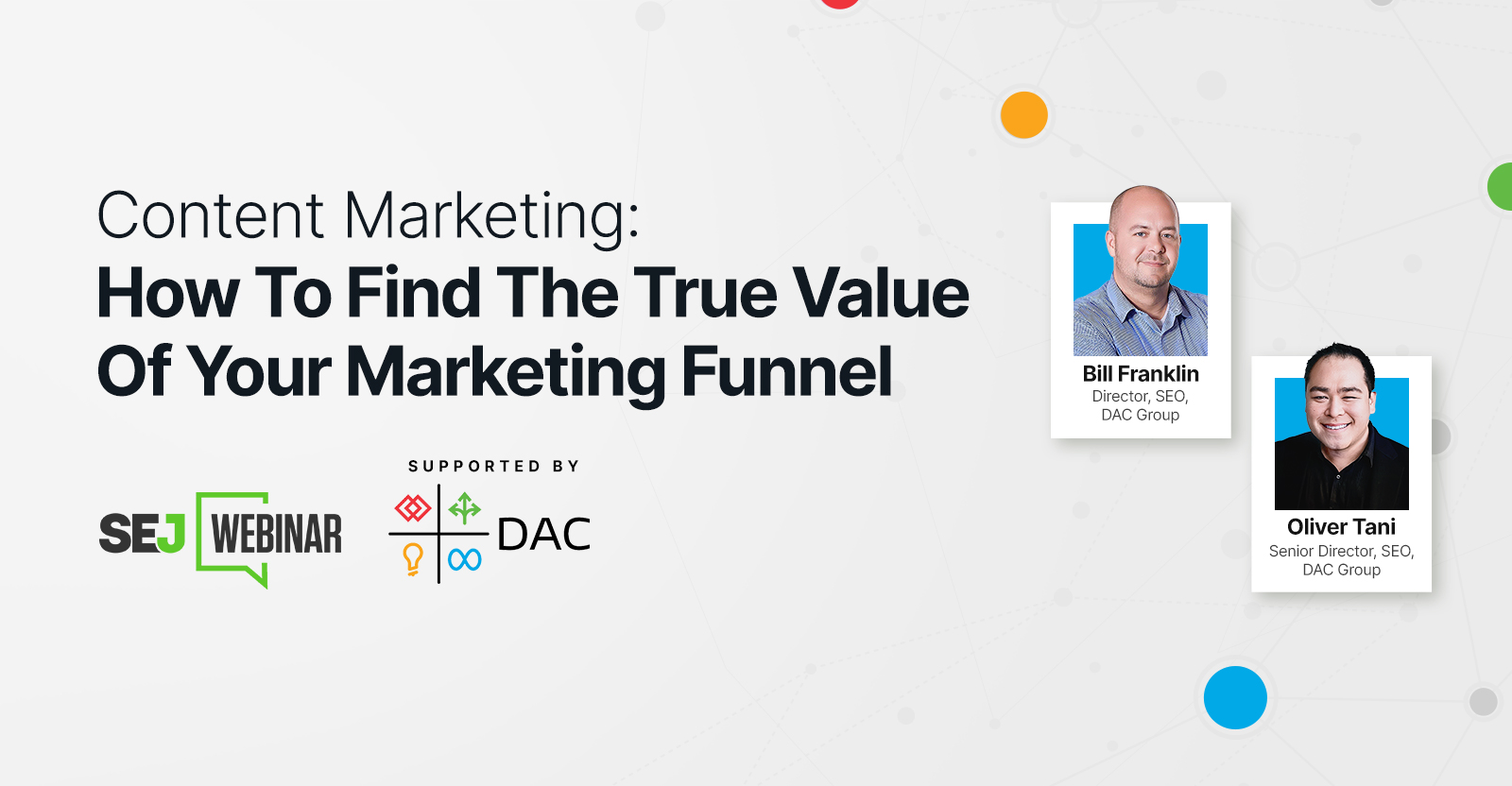
Understanding the impact of your content at every touchpoint of the customer journey is essential – but that’s easier said than done. From attracting potential leads to nurturing them into loyal customers, there are many touchpoints to look into.
So how do you identify and take advantage of these opportunities for growth?
Watch this on-demand webinar and learn a comprehensive approach for measuring the value of your content initiatives, so you can optimize resource allocation for maximum impact.
You’ll learn:
- Fresh methods for measuring your content’s impact.
- Fascinating insights using first-touch attribution, and how it differs from the usual last-touch perspective.
- Ways to persuade decision-makers to invest in more content by showcasing its value convincingly.
With Bill Franklin and Oliver Tani of DAC Group, we unravel the nuances of attribution modeling, emphasizing the significance of layering first-touch and last-touch attribution within your measurement strategy.
Check out these insights to help you craft compelling content tailored to each stage, using an approach rooted in first-hand experience to ensure your content resonates.
Whether you’re a seasoned marketer or new to content measurement, this webinar promises valuable insights and actionable tactics to elevate your SEO game and optimize your content initiatives for success.
View the slides below or check out the full webinar for all the details.
SEO
How to Find and Use Competitor Keywords
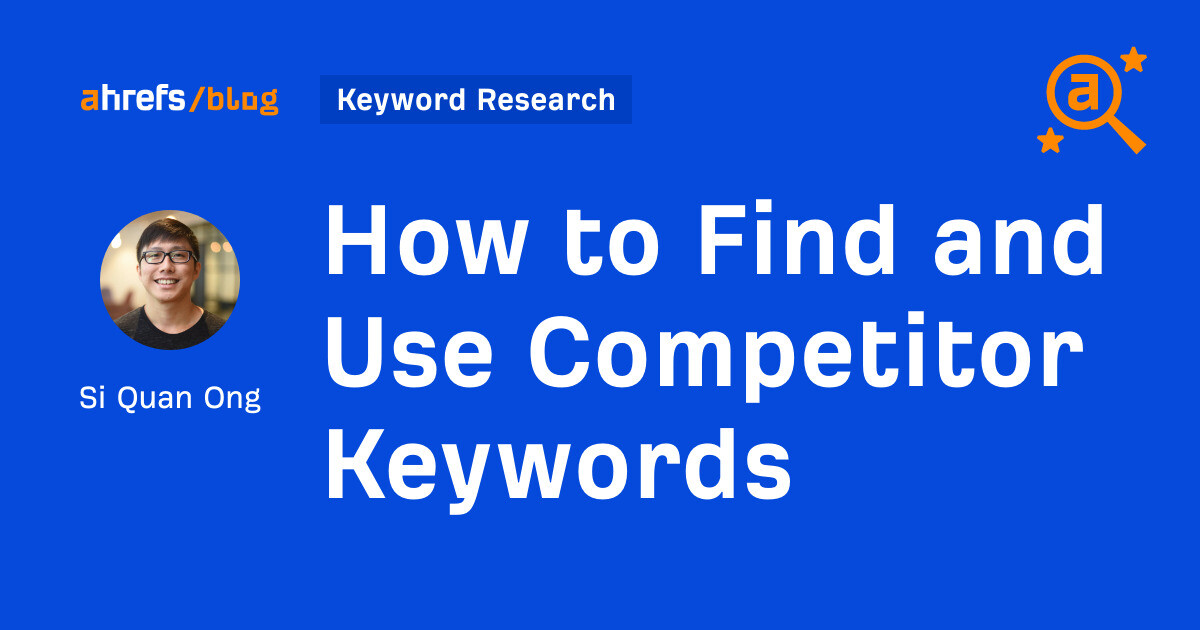
Competitor keywords are the keywords your rivals rank for in Google’s search results. They may rank organically or pay for Google Ads to rank in the paid results.
Knowing your competitors’ keywords is the easiest form of keyword research. If your competitors rank for or target particular keywords, it might be worth it for you to target them, too.
There is no way to see your competitors’ keywords without a tool like Ahrefs, which has a database of keywords and the sites that rank for them. As far as we know, Ahrefs has the biggest database of these keywords.
How to find all the keywords your competitor ranks for
- Go to Ahrefs’ Site Explorer
- Enter your competitor’s domain
- Go to the Organic keywords report
The report is sorted by traffic to show you the keywords sending your competitor the most visits. For example, Mailchimp gets most of its organic traffic from the keyword “mailchimp.”


Since you’re unlikely to rank for your competitor’s brand, you might want to exclude branded keywords from the report. You can do this by adding a Keyword > Doesn’t contain filter. In this example, we’ll filter out keywords containing “mailchimp” or any potential misspellings:
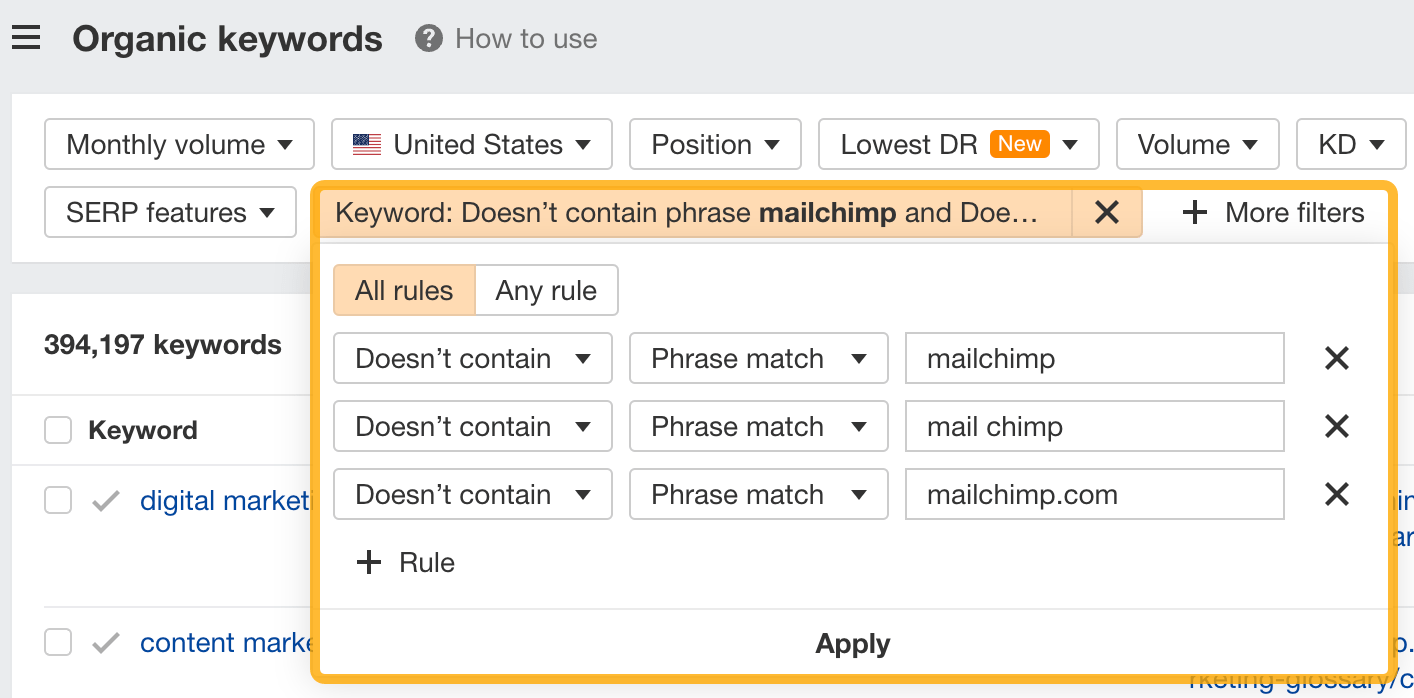

If you’re a new brand competing with one that’s established, you might also want to look for popular low-difficulty keywords. You can do this by setting the Volume filter to a minimum of 500 and the KD filter to a maximum of 10.
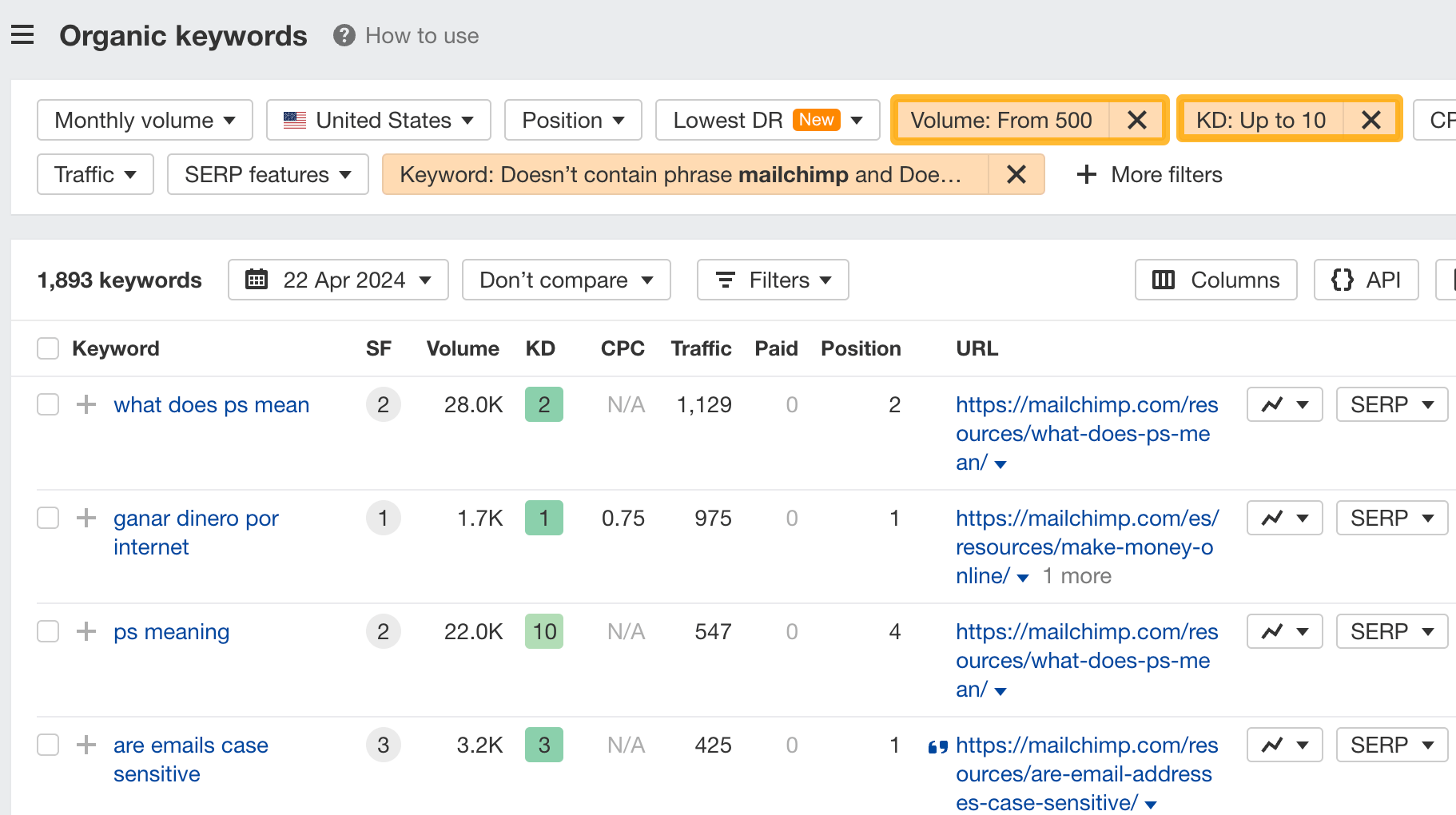

How to find keywords your competitor ranks for, but you don’t
- Go to Competitive Analysis
- Enter your domain in the This target doesn’t rank for section
- Enter your competitor’s domain in the But these competitors do section
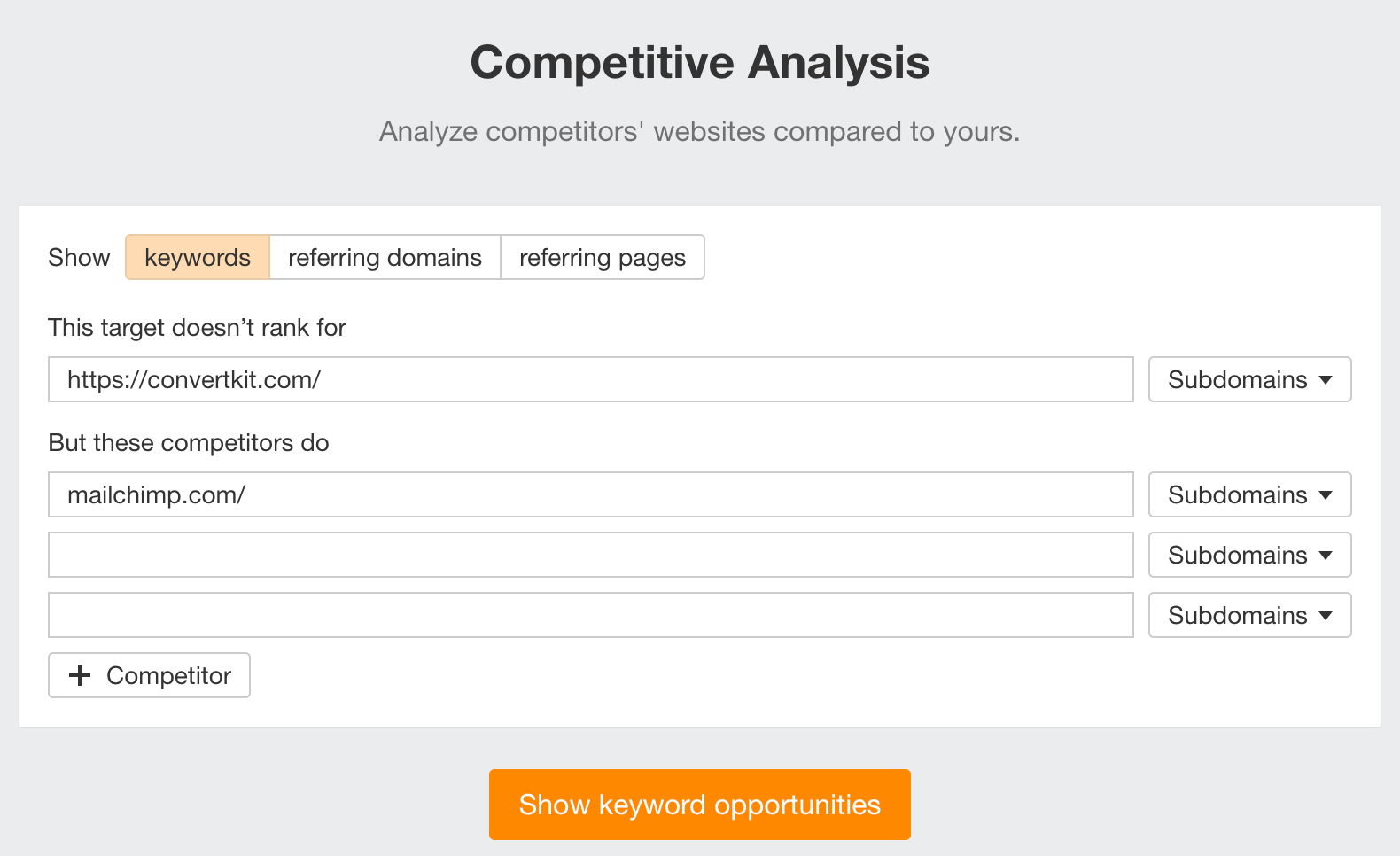

Hit “Show keyword opportunities,” and you’ll see all the keywords your competitor ranks for, but you don’t.
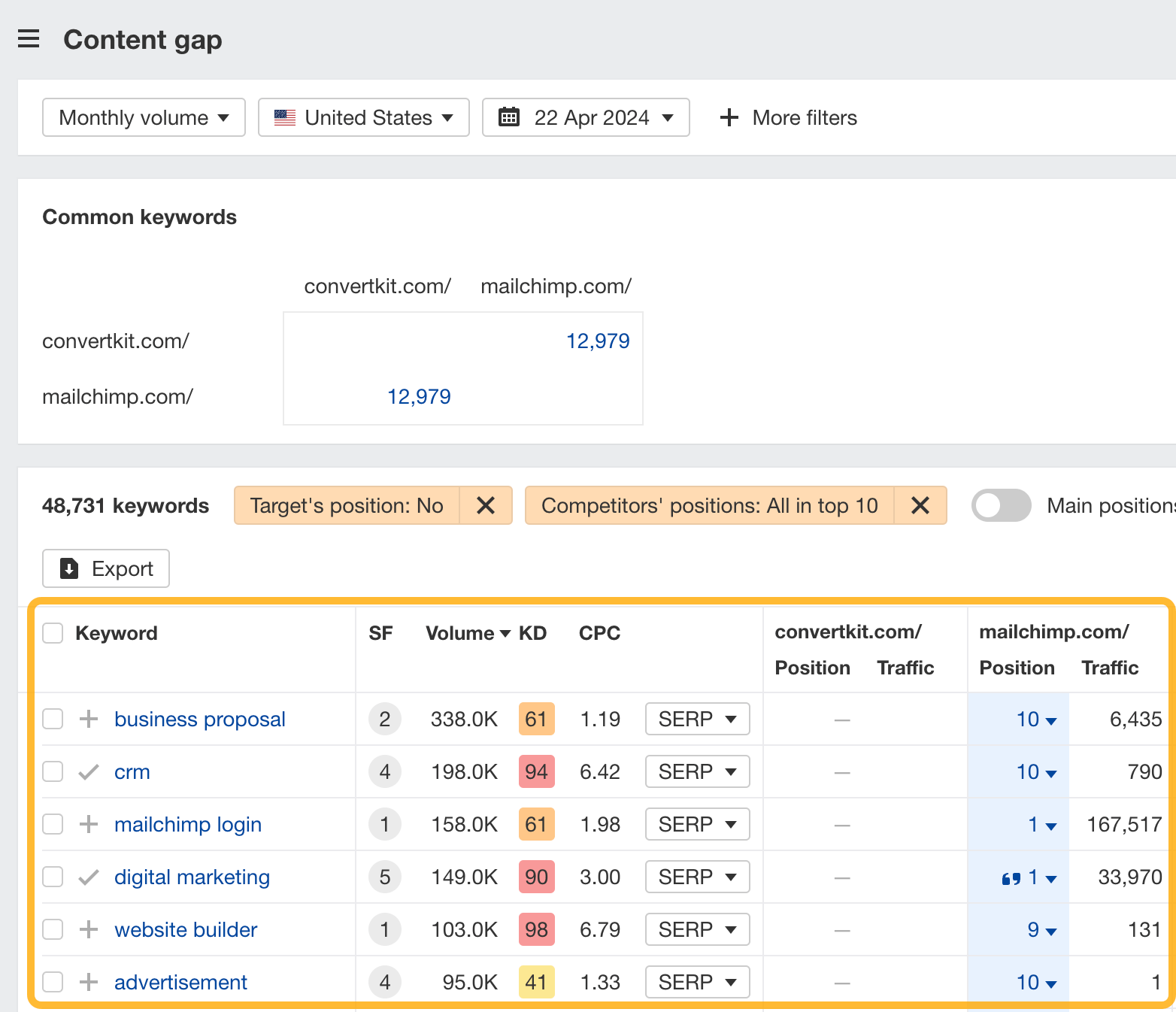

You can also add a Volume and KD filter to find popular, low-difficulty keywords in this report.
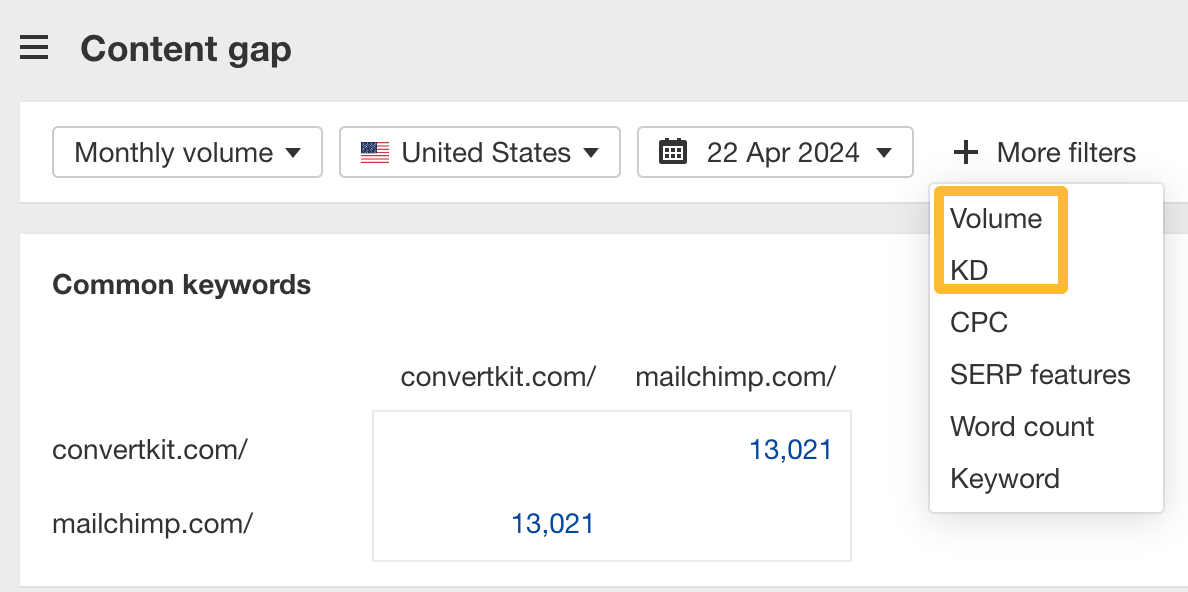

How to find keywords multiple competitors rank for, but you don’t
- Go to Competitive Analysis
- Enter your domain in the This target doesn’t rank for section
- Enter the domains of multiple competitors in the But these competitors do section
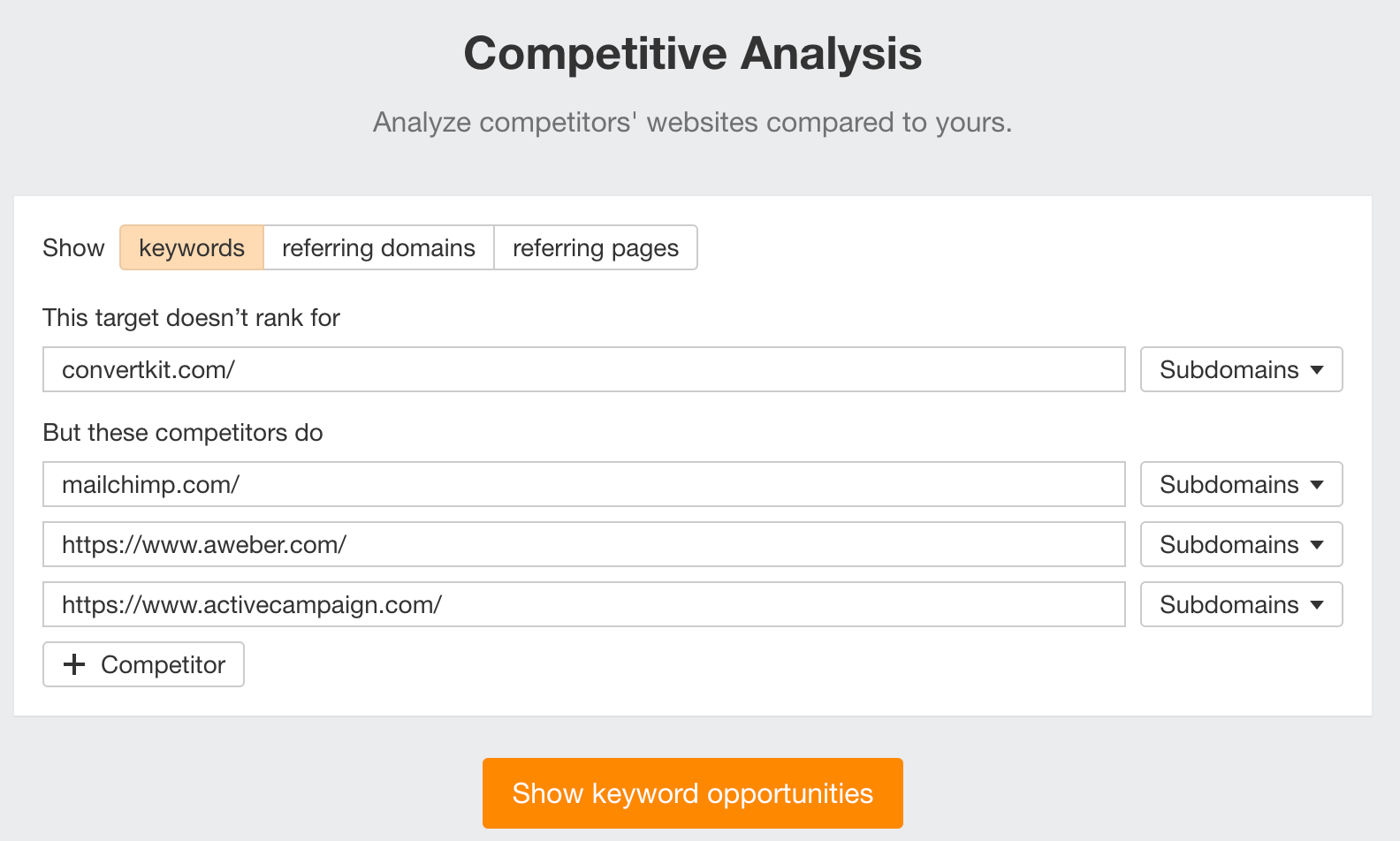

You’ll see all the keywords that at least one of these competitors ranks for, but you don’t.
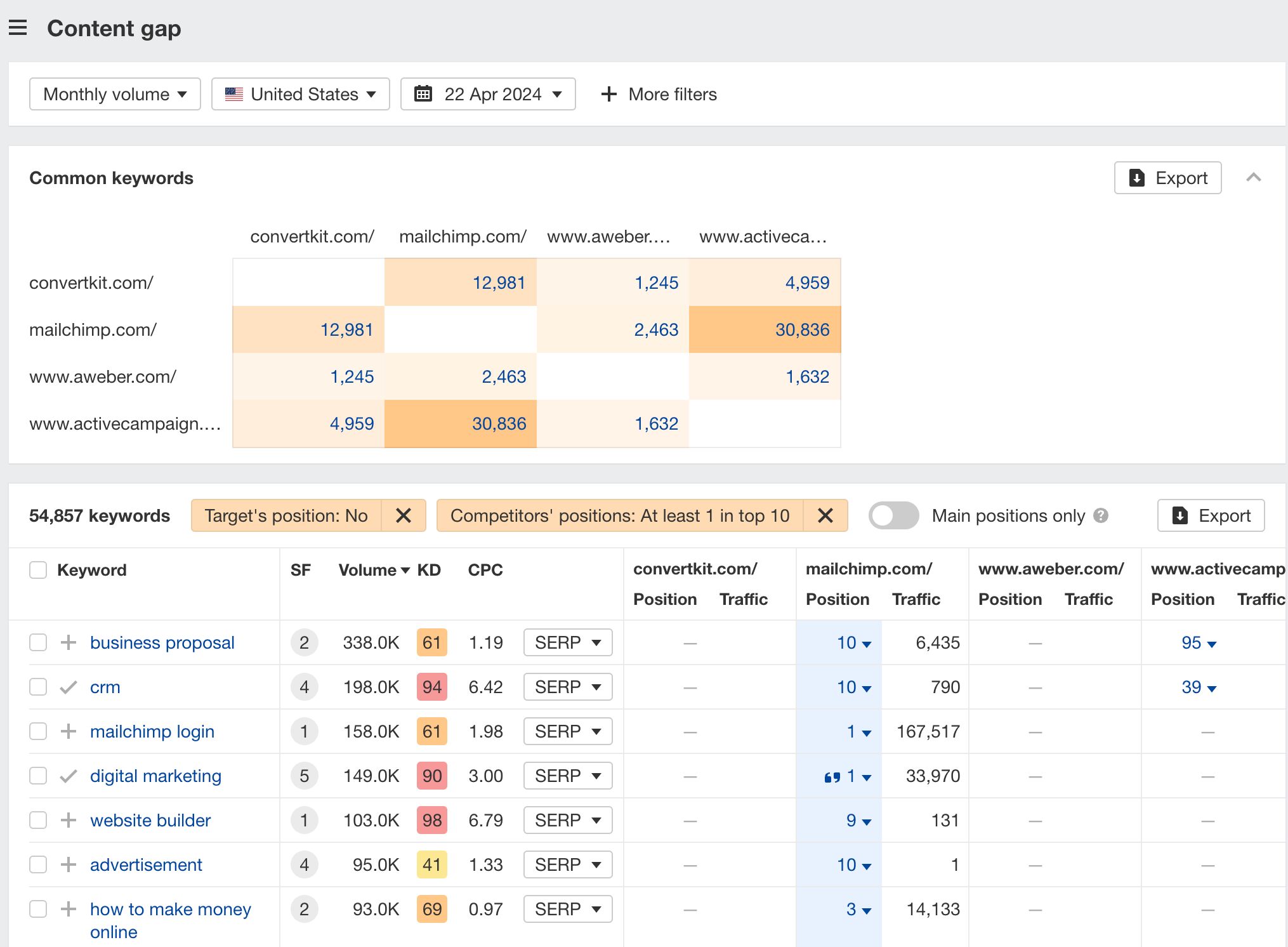

You can also narrow the list down to keywords that all competitors rank for. Click on the Competitors’ positions filter and choose All 3 competitors:
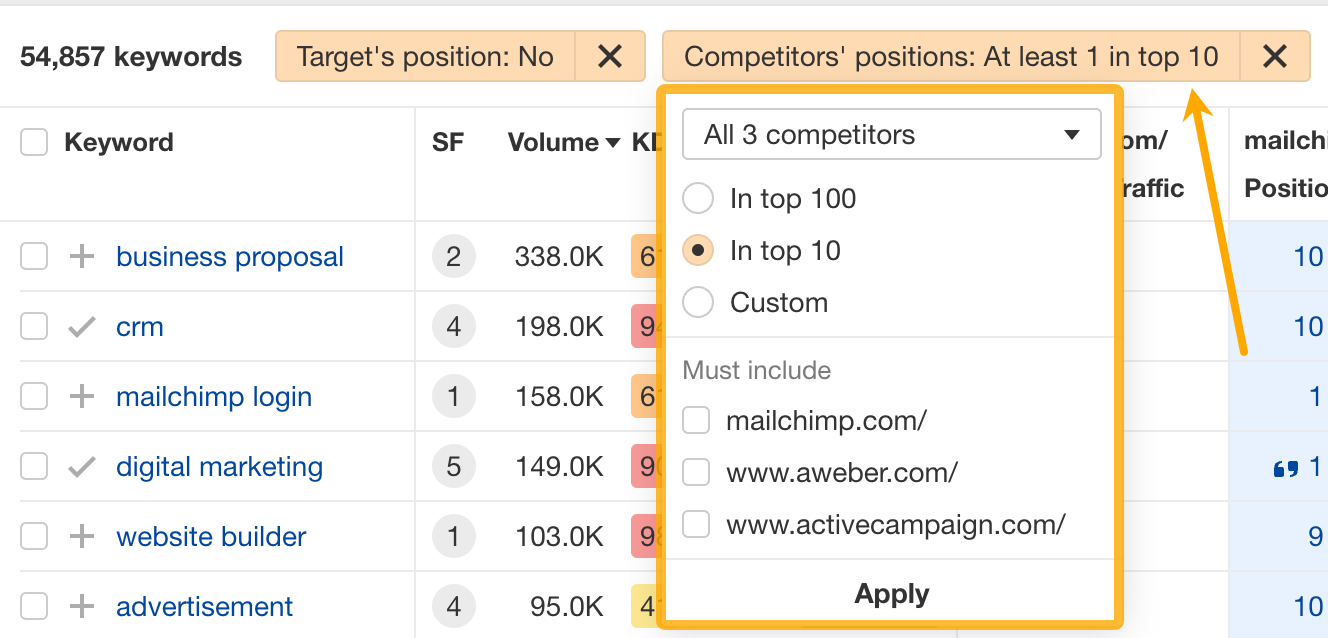

- Go to Ahrefs’ Site Explorer
- Enter your competitor’s domain
- Go to the Paid keywords report
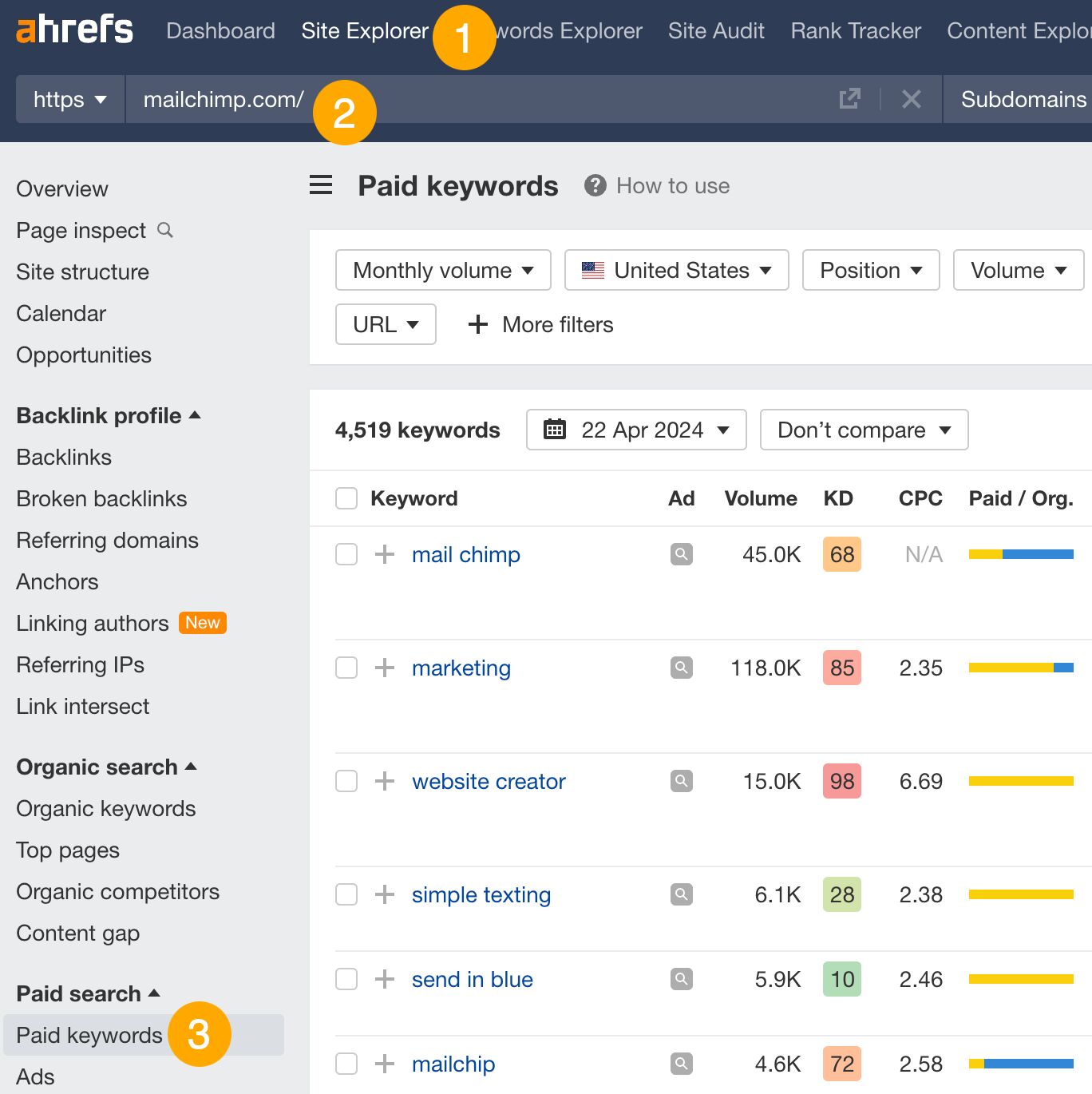

This report shows you the keywords your competitors are targeting via Google Ads.
Since your competitor is paying for traffic from these keywords, it may indicate that they’re profitable for them—and could be for you, too.
You know what keywords your competitors are ranking for or bidding on. But what do you do with them? There are basically three options.
1. Create pages to target these keywords
You can only rank for keywords if you have content about them. So, the most straightforward thing you can do for competitors’ keywords you want to rank for is to create pages to target them.
However, before you do this, it’s worth clustering your competitor’s keywords by Parent Topic. This will group keywords that mean the same or similar things so you can target them all with one page.
Here’s how to do that:
- Export your competitor’s keywords, either from the Organic Keywords or Content Gap report
- Paste them into Keywords Explorer
- Click the “Clusters by Parent Topic” tab
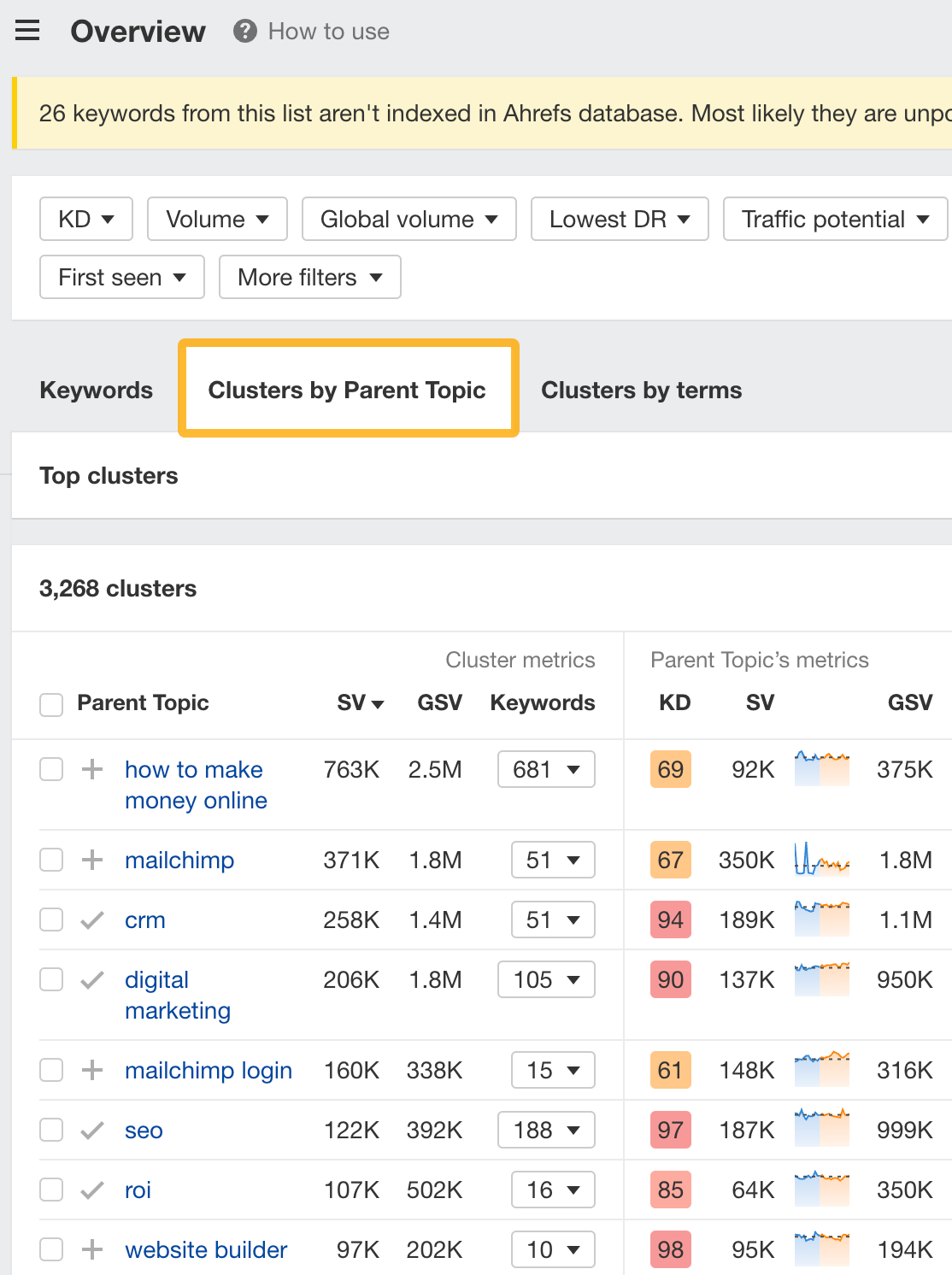

For example, MailChimp ranks for keywords like “what is digital marketing” and “digital marketing definition.” These and many others get clustered under the Parent Topic of “digital marketing” because people searching for them are all looking for the same thing: a definition of digital marketing. You only need to create one page to potentially rank for all these keywords.
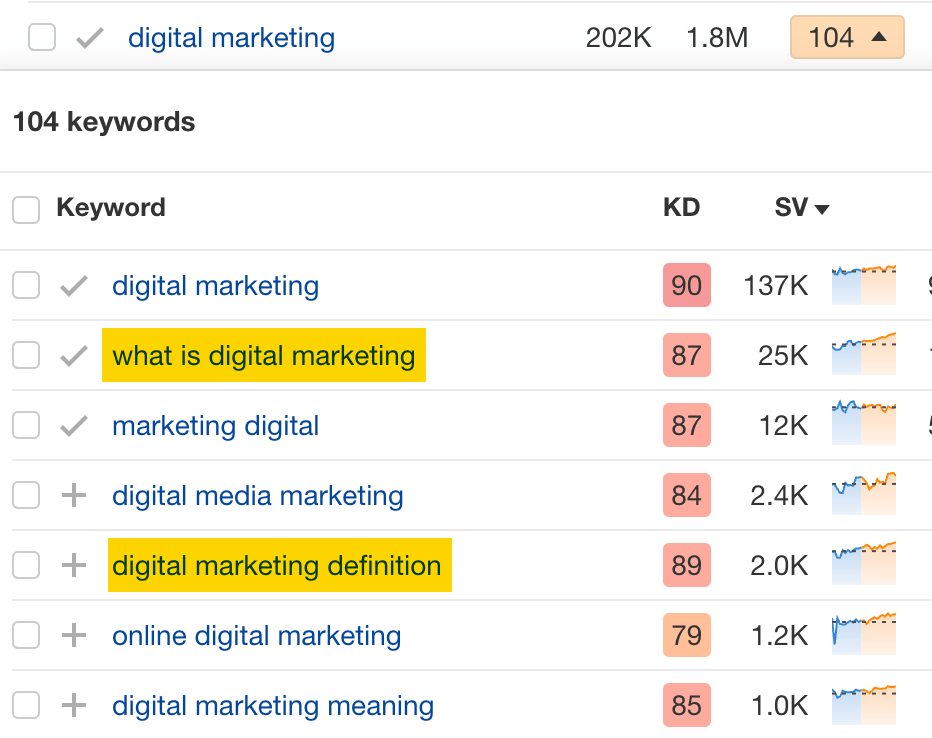

2. Optimize existing content by filling subtopics
You don’t always need to create new content to rank for competitors’ keywords. Sometimes, you can optimize the content you already have to rank for them.
How do you know which keywords you can do this for? Try this:
- Export your competitor’s keywords
- Paste them into Keywords Explorer
- Click the “Clusters by Parent Topic” tab
- Look for Parent Topics you already have content about
For example, if we analyze our competitor, we can see that seven keywords they rank for fall under the Parent Topic of “press release template.”


If we search our site, we see that we already have a page about this topic.


If we click the caret and check the keywords in the cluster, we see keywords like “press release example” and “press release format.”
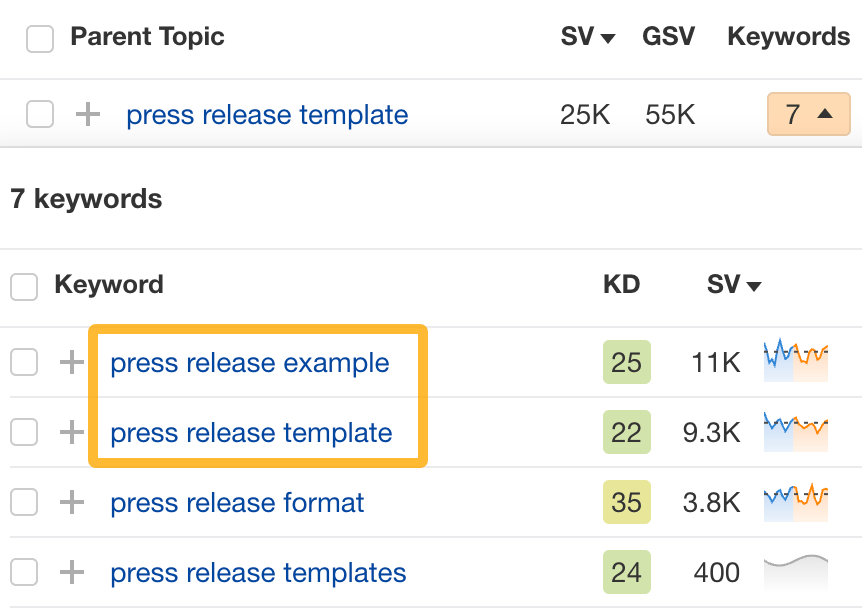

To rank for the keywords in the cluster, we can probably optimize the page we already have by adding sections about the subtopics of “press release examples” and “press release format.”
3. Target these keywords with Google Ads
Paid keywords are the simplest—look through the report and see if there are any relevant keywords you might want to target, too.
For example, Mailchimp is bidding for the keyword “how to create a newsletter.”


If you’re ConvertKit, you may also want to target this keyword since it’s relevant.
If you decide to target the same keyword via Google Ads, you can hover over the magnifying glass to see the ads your competitor is using.
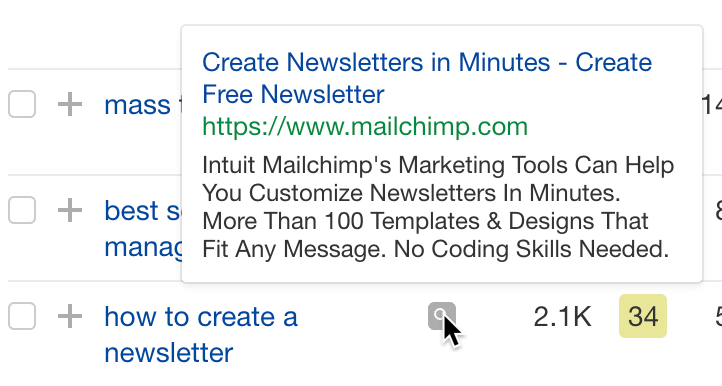

You can also see the landing page your competitor directs ad traffic to under the URL column.


Learn more
Check out more tutorials on how to do competitor keyword analysis:
SEO
Google Confirms Links Are Not That Important

Google’s Gary Illyes confirmed at a recent search marketing conference that Google needs very few links, adding to the growing body of evidence that publishers need to focus on other factors. Gary tweeted confirmation that he indeed say those words.
Background Of Links For Ranking
Links were discovered in the late 1990’s to be a good signal for search engines to use for validating how authoritative a website is and then Google discovered soon after that anchor text could be used to provide semantic signals about what a webpage was about.
One of the most important research papers was Authoritative Sources in a Hyperlinked Environment by Jon M. Kleinberg, published around 1998 (link to research paper at the end of the article). The main discovery of this research paper is that there is too many web pages and there was no objective way to filter search results for quality in order to rank web pages for a subjective idea of relevance.
The author of the research paper discovered that links could be used as an objective filter for authoritativeness.
Kleinberg wrote:
“To provide effective search methods under these conditions, one needs a way to filter, from among a huge collection of relevant pages, a small set of the most “authoritative” or ‘definitive’ ones.”
This is the most influential research paper on links because it kick-started more research on ways to use links beyond as an authority metric but as a subjective metric for relevance.
Objective is something factual. Subjective is something that’s closer to an opinion. The founders of Google discovered how to use the subjective opinions of the Internet as a relevance metric for what to rank in the search results.
What Larry Page and Sergey Brin discovered and shared in their research paper (The Anatomy of a Large-Scale Hypertextual Web Search Engine – link at end of this article) was that it was possible to harness the power of anchor text to determine the subjective opinion of relevance from actual humans. It was essentially crowdsourcing the opinions of millions of website expressed through the link structure between each webpage.
What Did Gary Illyes Say About Links In 2024?
At a recent search conference in Bulgaria, Google’s Gary Illyes made a comment about how Google doesn’t really need that many links and how Google has made links less important.
Patrick Stox tweeted about what he heard at the search conference:
” ‘We need very few links to rank pages… Over the years we’ve made links less important.’ @methode #serpconf2024″
Google’s Gary Illyes tweeted a confirmation of that statement:
“I shouldn’t have said that… I definitely shouldn’t have said that”
Why Links Matter Less
The initial state of anchor text when Google first used links for ranking purposes was absolutely non-spammy, which is why it was so useful. Hyperlinks were primarily used as a way to send traffic from one website to another website.
But by 2004 or 2005 Google was using statistical analysis to detect manipulated links, then around 2004 “powered-by” links in website footers stopped passing anchor text value, and by 2006 links close to the words “advertising” stopped passing link value, links from directories stopped passing ranking value and by 2012 Google deployed a massive link algorithm called Penguin that destroyed the rankings of likely millions of websites, many of which were using guest posting.
The link signal eventually became so bad that Google decided in 2019 to selectively use nofollow links for ranking purposes. Google’s Gary Illyes confirmed that the change to nofollow was made because of the link signal.
Google Explicitly Confirms That Links Matter Less
In 2023 Google’s Gary Illyes shared at a PubCon Austin that links were not even in the top 3 of ranking factors. Then in March 2024, coinciding with the March 2024 Core Algorithm Update, Google updated their spam policies documentation to downplay the importance of links for ranking purposes.
The documentation previously said:
“Google uses links as an important factor in determining the relevancy of web pages.”
The update to the documentation that mentioned links was updated to remove the word important.
Links are not just listed as just another factor:
“Google uses links as a factor in determining the relevancy of web pages.”
At the beginning of April Google’s John Mueller advised that there are more useful SEO activities to engage on than links.
Mueller explained:
“There are more important things for websites nowadays, and over-focusing on links will often result in you wasting your time doing things that don’t make your website better overall”
Finally, Gary Illyes explicitly said that Google needs very few links to rank webpages and confirmed it.
I shouldn’t have said that… I definitely shouldn’t have said that
— Gary 鯨理/경리 Illyes (so official, trust me) (@methode) April 19, 2024
Why Google Doesn’t Need Links
The reason why Google doesn’t need many links is likely because of the extent of AI and natural language undertanding that Google uses in their algorithms. Google must be highly confident in its algorithm to be able to explicitly say that they don’t need it.
Way back when Google implemented the nofollow into the algorithm there were many link builders who sold comment spam links who continued to lie that comment spam still worked. As someone who started link building at the very beginning of modern SEO (I was the moderator of the link building forum at the #1 SEO forum of that time), I can say with confidence that links have stopped playing much of a role in rankings beginning several years ago, which is why I stopped about five or six years ago.
Read the research papers
Authoritative Sources in a Hyperlinked Environment – Jon M. Kleinberg (PDF)
The Anatomy of a Large-Scale Hypertextual Web Search Engine
Featured Image by Shutterstock/RYO Alexandre
-

 PPC5 days ago
PPC5 days ago19 Best SEO Tools in 2024 (For Every Use Case)
-

 MARKETING6 days ago
MARKETING6 days agoStreamlining Processes for Increased Efficiency and Results
-
SEARCHENGINES6 days ago
Daily Search Forum Recap: April 17, 2024
-
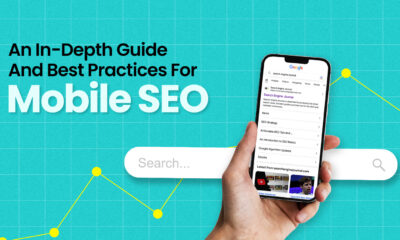
 SEO6 days ago
SEO6 days agoAn In-Depth Guide And Best Practices For Mobile SEO
-

 PPC6 days ago
PPC6 days ago97 Marvelous May Content Ideas for Blog Posts, Videos, & More
-
SEARCHENGINES5 days ago
Daily Search Forum Recap: April 18, 2024
-

 MARKETING6 days ago
MARKETING6 days agoEcommerce evolution: Blurring the lines between B2B and B2C
-
SEARCHENGINES4 days ago
Daily Search Forum Recap: April 19, 2024




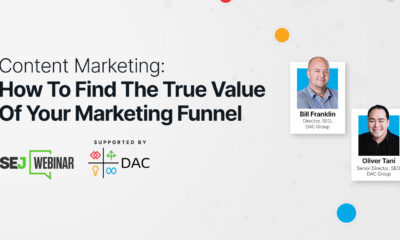



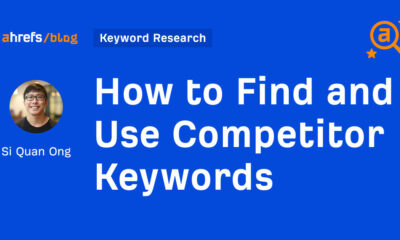







You must be logged in to post a comment Login